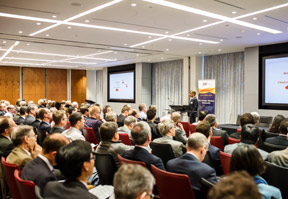The inaugural Cambridge Wireless Engineering and Technology Conference (CWTEC) yesterday set out to look at whether the wireless industry needs to integrate or differentiate and concluded that it should do both. Industry experts explored the future of the UK’s telecommunications infrastructure, spanning mobile, satellite, TV, IoT and wearable technology, focusing on the impact on licensed and unlicensed spectrum and the design of next generation mobile devices.
“Integration implies a closer technology and market coupling between traditionally separate sectors in the telecommunications industry while differentiation implies an increasing technology and market distance between each of these industry sectors,” said Geoff Varrall, chair of CWTEC event and opening speaker. “But it is perfectly possible to integrate and differentiate and there are many areas of mutual interest where it makes sense for the mobile broadband community to work more closely with the satellite and broadcasting industries, along with the low power device community and automotive industry. This extends across the whole range of alarmingly complex and costly spectrum and standards options.”
Sponsored by PwC and hosted at its London riverside offices, CWTEC attracted around 200 delegates to hear speakers from PwC, InterDigital Europe Ltd, Avanti Communications, EE, Keysight Technologies, BSkyB, Radio Design, Anritsu, Qualcomm, IRT, BBC Research and Development, Interlligent UK, u-blox AG, CSR and Samsung Cambridge Solutions Centre.
With increasing interest in 4G to 5G transition, speakers at CWTEC explored the challenges ahead and looked at the integration of terrestrial and satellite, including 20 to 40GHz Ka-band satellite platforms and 60 GHz terrestrial networks. “With the British government recognising the need for satellites for universal delivery of broadband in the UK and major internet players starting to look at satellite technology to deliver internet to the world’s most digitally deprived, the focus on unfettered and secure connectivity has never been more timely,” said Graham Peters, director of Avanti Applied Technologies.
“Dealing with interference issues lies at the heart of making the most of any spectrum and managing co-existence is driving RF front end design, leading to exciting concepts from antennas, through filters and into analogue and digital cancellation techniques,” commented Martin Gostling, director of Technology, Radio Design in his presentation addressing the issues of coexistence management and capacity gain. “5G is more than just a new air interface, it’s a revolution in how we manage, control and run networks,” adds Dirk Trossen, principal engineer, InterDigital Europe and one of the CWTEC organisers.
Liam Devlin, non-executive director of Interlligent UK and CEO of Plextek RFI, opened the session on Machine to Machine and Wearable Connectivity that explored issues from device size, power and cost to whether existing radio systems and spectrum for connecting people may not work so well for machines and the case for dedicated spectrum for the IoT. “Low power is critical for many of these emerging technologies yet small radio systems don’t necessarily lead to low power consumption without making some specific design choices and employing techniques that can be applied to wearable products and the IoT,” said Paul Morris, Fellow at CSR.
“Henry Ford’s success with the motor car was built on a combination of technology, process innovation and optimised manufacturing,” said Geoff Varrall. “In many ways that is what is happening in the wireless industry today. The cost of complexity has forced consolidation in the user device space and the next big change will be driven by new materials and the ability to manufacture with ultra-thin molecular structures such as graphene.”
“The first CWTEC event lived up to expectations and provided a vibrant and dynamic form for harnessing knowledge, driving lively debate and high-level networking,” said Sylvia Lu, committee member of CWTEC and senior algorithm and standards engineer of u-blox AG. “As well as focusing on emerging engineering trends and challenges, the event explored the important relationships between technology innovation and their commercial and economic consequences.”










